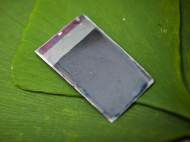Artificial leaf uses solar energy to split the oxygen and hydrogen in water
 Researchers at the Massachusetts Institute of Technology (MIT) have produced something they’re calling an “artificial leaf” – a silicon solar cell with different catalytic materials bonded onto its two sides which enable it to produce oxygen and hydrogen. Once the material is placed under water and illuminated by sunlight, it needs external sources of power or control circuits to operate.
Researchers at the Massachusetts Institute of Technology (MIT) have produced something they’re calling an “artificial leaf” – a silicon solar cell with different catalytic materials bonded onto its two sides which enable it to produce oxygen and hydrogen. Once the material is placed under water and illuminated by sunlight, it needs external sources of power or control circuits to operate.
Other attempts to produce devices that employ sunlight to split water have relied on corrosive solutions or on relatively rare and expensive materials. Led by MIT professor Daniel Nocera, the Henry Dreyfus Professor of Energy and Professor of Chemistry at MIT, the researchers developed a device made entirely of abundant and inexpensive materials such as silicon, cobalt and nickel.
The artificial leaf is a thin sheet of semiconducting silicon which turns the energy of sunlight into a flow of wireless electricity within the sheet. Bound onto the silicon is a layer of a cobalt-based catalyst, which releases oxygen, a material whose potential for generating fuel from sunlight was discovered by Nocera and his colleagues in 2008. The other side of the silicon sheet is coated with a layer of a nickel-molybdenum-zinc alloy, which releases hydrogen from the water molecules.
The leaf can redirect about 2.5 percent of the energy of sunlight into hydrogen production in its wireless form, while its efficiency gets up to 4.7 percent when it has wires which connect the catalysts to the solar cell rather than bonding them together. Compared to current typical commercial solar cells which have efficiencies of more than 10 percent (or prototypes achieving over 50 percent of efficiency), these results aren’t very impressive.
However, researchers are working on optimization of the system and testing different configurations in order to determine which of these configurations will be more efficient and cost-effective in the long run. The new device is not yet ready for commercial production, since systems to collect, store and use the gases remain to be developed.
Another line of research is to explore the use of photovoltaic materials other than silicon — such as iron oxide, which might be less expensive to produce. Along with optimization and the development of more efficient and affordable photovoltacs (solar cells), the technology could be used in individual homes where it could produce hydrogen and oxygen that would be stored in tanks, and then fed to a fuel cell whenever electricity is needed or be used to produce the fuel for vehicles.
For more information, read the paper published in the journal Science named: “Wireless Solar Water Splitting Using Silicon-Based Semiconductors and Earth-Abundant Catalysts”.









Daniel G. Nocera, Ph.D., described the advance during the “Kavli Foundation Innovations in Chemistry Lecture” at the 245th National Meeting & Exposition of the American Chemical Society.
“Surprisingly, some of the catalysts we’ve developed for use in the artificial leaf device actually heal themselves”, said Nocera, who moved his research to Harvard University where he currently teaches. “They are a kind of ‘living catalyst.’ This is an important innovation that eases one of the concerns about initial use of the leaf in developing countries and other remote areas.”
Nocera explained that the artificial leaf likely would find its first uses in providing “personalized” electricity to individual homes in areas that lack traditional electric power generating stations and electric transmission lines. Earlier versions of the leaf required pure water, because bacteria eventually formed biofilms on the leaf’s surface, shutting down production, but the researchers found a way to adjust the conditions when a part of the catalyst falls apart in order to deny the bacteria a chance to form a biofilm. The catalyst then re-assembles and ‘heals’.
The next step researchers have planed to achieve is to integrate their findings with technology for converting the hydrogen into a liquid fuel that could run traditional portable electric generators or hydrogen powered vehicles.